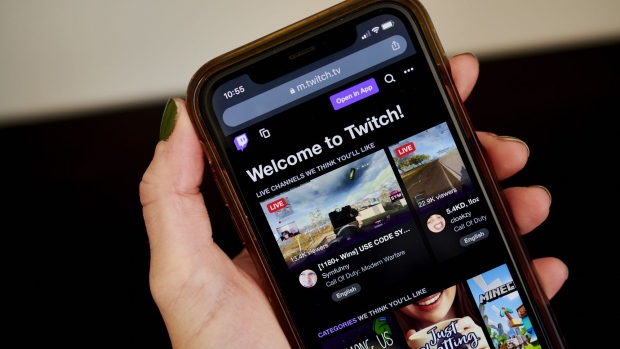Apr 27, 2022
Amazon’s Twitch Seeks to Revamp Creator Pay With Focus on Profit
, Bloomberg News

(Bloomberg) -- Twitch, the Amazon.com Inc.-owned live-streaming website, is weighing potential changes to how it pays top talent, said people familiar with the planning, an effort that would boost its profits but would also risk alienating some of its biggest stars.
The updates under consideration would offer incentives for streamers to run more ads. The proposal would also reduce the proportion of subscription fees doled out to the site’s biggest performers, said the people, who asked not to be identified because the discussions are private.
Some changes to Twitch’s monetization structure could be implemented as soon as this summer, the people said. Twitch staff is considering paring back the revenue cut of channel subscriptions granted to the top echelon of streamers in its so-called partnerships program to 50%, from 70%. Another option is to create multiple tiers and set criteria for how to qualify for each one, two of the people said. In exchange, Twitch may offer to release partners from exclusivity restrictions, allowing them to stream on Google’s YouTube or Facebook.
Updates to the partnerships program aren’t finalized and could be abandoned, the people said. A representative for Twitch declined to comment.
Viewership for live videos of people playing video games has exploded in recent years and has elevated a new class of internet celebrities. Twitch leads the market, but Amazon increasingly wants the site to make money over the long term. The unit has recently gone to work on new, profit-driven programs, but some employees have said the shift hurts its users. There has been an exodus in recent months of top and longtime employees who said Twitch has lost touch with its community’s needs, Bloomberg has reported.
Twitch still has a large stable of stars. It has more than 51,500 people in its partnership program, according to research from TwitchTracker, including the likes of Thomas “Tommyinnit” Simons, who has amassed some 9,000 subscribers to watch him play games like Minecraft. Viewers can subscribe to an individual streamer for $5 to $25 a month and receive digital badges, custom emoticons and other perks. Typically, streaming partners get half of the subscription revenue from their channels, but Twitch routinely awards the top performers a higher cut.
Partners currently earn, in addition to subscriptions, a fee for running ads on their channel. That rate, $3.50 to $5 for 1,000 ad impressions depending on a streamer’s location, has remained essentially unchanged for years.
Recently, though, Twitch has been experimenting with other approaches to ads. This year, it said creators who stream at least 40 hours a month could receive $100 for running two minutes of ads per hour. The payout increases with more ad minutes. A new proposal being considered would create a revenue-sharing arrangement, presenting a more lucrative model for streamers.
Ads are controversial on the platform because they interrupt live programming. Viewers often complain that they miss important moments of a streamer’s gameplay, and performers have said ads can alienate the audience and hurt their metrics. But some Twitch streamers see ads as a necessary nuisance to support their businesses when subscriptions alone won’t suffice.
For Amazon, running a large-scale live-streaming business is expensive. Amazon purchased Twitch in 2014 for $970 million, and after years of prioritizing growth, Twitch executives are increasingly focused on financial sustainability. Twitch’s ad push is in line with a broader move across the media industry. Last week, Netflix Inc. said it was experimenting with ads. Sony Group Corp., too, is planning to sell ads inside PlayStation games, Insider reported.
Twitch leadership has discussed possible changes to its 10-year-old partner program for several years. Early discussions referenced performers’ complaints about work-life balance. Some toil for as long as 12 hours a day. Twitch employees began tossing around the idea of offering health care benefits or the ability to pause subscriptions during a vacation so they wouldn’t worry about losing patrons.
The focus today is more on monetization. With Twitch established as the premier destination for game live-streaming, top talent has fewer alternatives to reach large audiences. In the past, YouTube and Facebook Gaming offered enormous sums of money to lure top creators, but these deals are rare and not always successful. Several streamers returned to Twitch after their contracts were up with Facebook Gaming or Microsoft Corp.’s now-defunct Mixer.
©2022 Bloomberg L.P.





